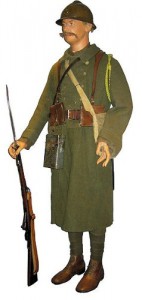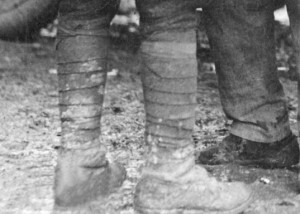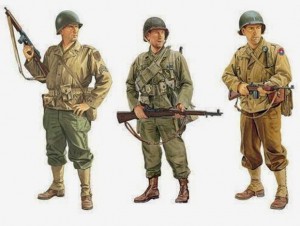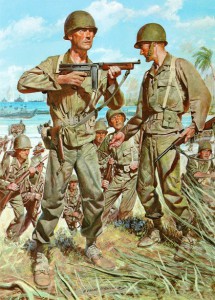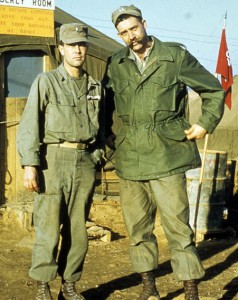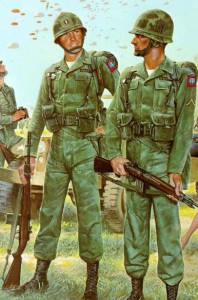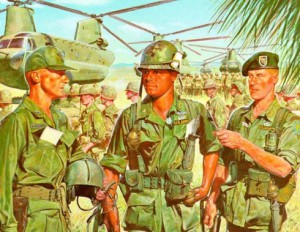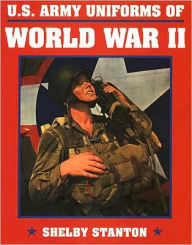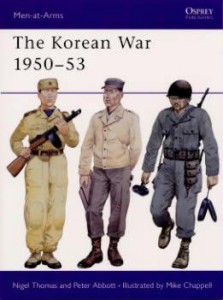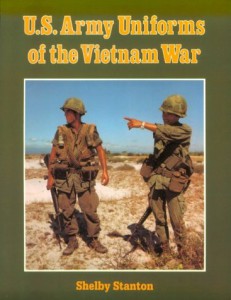
…August 22, 1914. The day started with heavy fog and no idea where the German army might be. At least the French knew where *they* were… spread out from Northern France into Southern Belgium. As the fog began to burn off, most of the men found themselves in forest country… and the Germans were immediately to their front. Following doctrine, their officers ordered an immediate frontal bayonet attack.
…For years the French High Command had stressed the attack… always the attack. Whatever the casualties, the “elan” of the French soldier would always sweep the enemy away it was firmly believed. “Elan” is always a fine thing…but it is never a substitute for good tactics. At the end of the day the bullets don’t care how brave you are.
…The French launched frontal assaults all along the line of contact. Fourteen separate actions lumped into one battle known as “The Battle of the Frontiers…” The ghastly lessons of the American Civil War had been largely ignored by European generals who dismissed the American armies as “armed mobs chasing each other around the countryside…” The French, at least, were getting a crash course this August day.
…Bayonets against machine guns in frontal assaults just left ever increasing piles of bodies. The French troops and their regimental officers displayed all the “elan” in the world… Attack after attack, moving over the bodies of their fallen comrades…all to no avail.
…Larger numbers of French soldiers would die in other battles during that war… but not in a single day. The Battle of the Frontiers took the lives of 27,000 of France’s finest young men in one day… 7000 more killed than the British lost the first day at the Somme.
…Most of the world… even most of France, has forgotten; the next four years blurring the image. The French government censored all casualty reports and it was years before historians could learn the casualty figures and match them to the specific action.
…The local villagers have kept the memory alive…but mostly because on that day German troops in a number of villages in the same area were ordered to kill civilians… males in some villages… everybody in others… as “reprisals” for suspected “franc-tireur” (partisan) actions that never occurred.
…The grim logic of 20th Century warfare had arrived, with a vengeance. Close order frontal assaults against steady troops with modern firepower would become little more than massed death swarms. And then there was the problem of facing an enemy behind cover whose uniforms blended in with the terrain, while your troops in the open wore bright blue coats and blazing red trousers with matching kepis.
While this article deals mostly with the American military experience regarding combat uniforms…reference must be made to European forces in WWI. You can read Part 1 here.
By 1914 most European armies had “drab” or “earth toned” uniforms available for their troops…most often in shades of khaki or green. But for the glory minded French generals such uniforms were suitable only for small dirty colonial wars on the far frontiers of Asia or Africa. For a European war (uniforms last updated in 1870) Napoleonic splendor was required.
It might seem that by 1912 any cheeseburger could figure out that Napoleonic splendor was at a disadvantage when facing modern bolt action rifles, smokeless powder and machine guns. But when a reformer in the French Assembly suggested “toning down” the combat uniform (as the English and Germans already had)…at a minimum replacing the blazing red trousers… the French Minister of war sprang to his feet and shouted him down: “Jamais! Le pantalon rouge c’est la France!” (“Never! The red trouser *is* France!”) And that of course, trumped all logic.
By early 1915, after catastrophic losses, the French Army decided that “Le pantalon rouge” was a luxury that it could no longer afford. But rather than go with an earth tone, they produced field uniforms that from head to foot were in a color that they referred to as “horizon blue…” (Think “powder blue…”) Somewhat of an improvement, but not only failed to blend into many backgrounds, but the color was profoundly “un-martial…”
Green tone French uniforms followed and were better designed for the rigors of the Western Front. The New Model French “Greatcoat” was far more serviceable than the old dark blue one. While “elan” tactics would persist for a time, at least the soldiers were no longer “blazing targets…”
The British wore a type of “khaki” uniform. “Khaki” can run from an almost white sand color to a brown or near green tone. The Germans wore “Feldgrau” or “field gray” uniform. Shades could vary, but quite often the uniforms started out as more of a green color and fade into what would be called gray… though some units actually started with all gray uniforms.
The American Expeditionary Force pretty much followed the British model. Field grade and higher ranking American officers often had their uniforms tailored in London. Shades of “khaki” might range from a tan to possibly a “mustard green…”
Many American officers wore “riding boots” and the fashion was to attach spurs… even if they never sat a horse… (To achieve the European image of gentlemen officers…) Marine Corps officers shunned the spurs (except when attached to Army staffs where they were required to wear them… A ceremony of sorts held on the transports heading home… as the Marine officers forced to wear spurs, tossed them into the ocean…)
American “campaign hats” (think D.I. type headgear) soon put aside and replaced by flat folding overseas caps… or British model helmets.
In 1914 the armies entered combat without proper helmets. Modern artillery with greatly increased fragmentation inflicted head wounds on a scale not seen before.
Except for German cavalry… the German “pikelhaube” helmets with the “spike” on top were not made of metal… but of boiled leather (designed to deflect sword strokes.) Would not stop shell fragments (referred to generically as “shrapnel”, though that was only one type of fragment…)
The French came up with a serviceable helmet, the Germans with the iconic “coal scuttle helmet. The British, (and the Americans in that war) eventually went into battle with a type of helmet very close in appearance to that worn by English armies during the 100 Years War. Helmets reduced serious head wounds (compared to troops without them) by up to 70%…
While “leggings” of a sort had been worn by American, British and French troops elsewhere… enlisted men soon came to be equipped with “puttees” (the name comes from India, though various tribal peoples ranging from Central Asia to the Apaches have at times worn them.)
******
Puttees were pre-measured lengths of a very thin blanket-like cloth wound round the leg. Protected the lower trouser legs from being torn in the field. Cheaper than dirt. (I was forced to use them in a special training unit for a time… but that is a story for another day…)
It takes a fair amount of practice to apply them correctly. If not done perfectly, they will start to unravel… (usually at the worst possible time…) Even more so than “gaiters” or leggings, they are time consuming to apply and remove. For infantry this meant fewer opportunities to clean feet and change socks. Some reports of issues involving varicose veins and other circulation issues.
While the red trousers and “horizon blue” uniforms had vanished, total war (on the Western Front at least) had not produced truly practical, or comfortable uniforms. “Combat” uniforms would have been more at home on a parade ground.
One might think that top buttons buttoned on jackets would only be mandated during a gas attack… but armies went into attacks with troops so encumbered. Worse, some coats had tops that were more like “stocks” to keep the chin up… just one step removed from the old leather stocks of the early 19th Century. And some uniform jackets (such as many issued to Americans) were so “form fitted” as to make them look a size or two too small. Function and comfort still not a top priority.
Between the two World Wars American troops did their active campaigning mostly in “…sunny tropic scenes…” from Haiti to Nicaragua. Khaki uniforms sufficed. The two Marine regiments that deployed to North China at various times wore modified WWI uniform… (looser fitting, open collar… often with tie when not under fire.)
The American military was “resistant” to the idea of a fully functional combat uniform. It was grudgingly admitted that some work details (cleaning out garbage pits, etc.) needed something more functional and the 1937 indigo denim work outfit was issued to those requiring it. Usually a jacket and trousers with floppy “clam-digger’s” hat, the only thing military about it was the uniform belt. (A few commanders insisted upon the wool shirt being worn with it…sometimes even with necktie!)
After Pearl Harbor a few commands (especially Stateside) had troops turn out in denims with helmet, cartridge belt, and leggings. But soon they were again relegated to cleaning garbage pits… stockades… and as issue to enemy prisoners of war.
In the European Theater of War (to include North Africa), the American Army’s idea of a combat uniform was wool trousers (referred to as “O.D., but like “khaki” that came in various shades…), wool shirt (to be worn open, though a few commanders insisted upon ties for a time), a short, lightweight “field jacket” and leggings.
Later the wool trousers would be replaced with green “herringbone” twill (HBT) “fatigue” trousers. All HBT uniforms were issued, but some Stateside commands initially used only in place of the indigo denims. Somehow the idea was that the HBT would be worn over the wool uniform (some units with a necktie!) but rapidly the practical fatigues were worn on their own.
The 1943 issue of this uniform in the ETO (along with vastly more efficient longer, warmer, and more wind resistant dark green cotton sateen field jacket) was bitterly resisted by some American commanders in the field. But the supply system, combined with replacements arriving in the newer uniforms saw to it that by late 1944 the change was largely complete in most units.
Airborne units had their own distinctive uniform… baggy fatigue trousers, jump boots and jacket with upper “slash pockets”, lower cargo pockets, fabric belt and snap closures. Colors ranged from early desert tans to various shades of olive and green.
In the losing battles of 1942 in places like the Philippines and Wake Island, the Army and Marines fought in what they had…khaki shirts and trousers. But by August of 1942 the Army and Marines entered combat wearing the green dungarees. Neither service experienced any serious opposition within their commands in the Pacific to these fully functional uniforms. (I’ll cover camouflage uniforms in part 3.)
In both Theaters shoes were replaced with low-cut boots (in the Marine Corps these were called “boondockers…”) Leggings were issued, but once in combat (especially in the Pacific) many men simply did not wear theirs at the “sharp end…” Being able to remove boots during brief stops was facilitated by this… and, especially in the Pacific, not just the trouser legs… but the entire fatigue uniform would be in shreds soon enough.
The Army was not going to issue “jump boots” to all its infantry, but by 1944 started issuing low-cut boots with buckle flaps sewn on. A practical combat boot was now being issued to soldiers in the field.
…The years between WWII and Korea saw some minor R&D, but the war was essentially fought with the same weapons… and the same uniforms. The South Korean Army wore U.S. fatigues in combat as did all U.N. contingents except most of the British Commonwealth Brigade.
The Pentagon had cleverly decided that there would be no more ground wars, so after WW2 vast stocks of fatigue uniforms had been sold to the surplus market. But then pesky Korea came along, demanded entire divisions… and an increase in the Army at home and abroad. For a time there was a shortage of combat fatigues. North Korean and Chinese POWs were often issued U.S. officers’ khaki shirts and trousers in lieu of fatigues.
Army warehouses around the country were searched and fatigues were found… many different designs… including one pattern with trousers that had a giant pocket centered on the rump. Pockets ran from small to gigantic… buttons of all kinds. In short, there was little “uniform” about the uniforms.
By the end of the Korean War both the Army and the Marine Corps decided to sort everything out. Each had fatigues designed to meet its own preference (and boots as well). The days of combat fatigues that had all the tailoring of potato sacks was now a thing of the past.
Combat uniforms would be (in theory) better fitting and look sharp when starched (garrison only… not at the sharp end…) Flat buttons would later be replaced with far thicker ones that would not easily snap or crush. Depending on unit, trousers would either be tucked into boots…or “blousing bands” used. Presented a neat appearance and went some way to keeping bugs out.
The new Army fatigues were better designed and fit better (some individuals and units “fine tuned” tailoring them as well…). Looked sharp. Maybe too sharp for combat use. White name tape, gold on black “U.S. ARMY” tape… colored division patches, jump wings, and full size gold sleeve rank for the enlisted and silver or gold insignia for the officers.
The Marine Corps went with an elegant “minimalist” design. All of the buttons on the shirt were covered, producing a smooth appearance. Little else was added, small black metal enlisted pin-on collar rank insignia. Officer collar rank insignia same as Army, but only 1/2 the size. Iron on Marine Corps Eagle, Globe and Anchor and USMC on left breast pocket.
For some odd reason the Third Marine Division in Okinawa bucked the trend and had white name tapes over the right shirt pocket. Heavy duty and durable, the shirt’s suitability for tropical deployment was further reduced by a very large map pocket inside the left breast.
Prior to and during WW2 the military dabbled in research on tropical combat uniforms. Some ideas would come to fruition decades later… others (such as very high top jungle boots with about 25 buttons) died unlamented.
The Army had been experimenting with jungle uniforms for its advisors in Vietnam, but suddenly in March of 1965, thousands of American troops started to arrive…wearing their Stateside combat uniforms. Those needed replaced… as did the all leather boots (which would soon rot…)
Jungle boots…soon with metal “punji stick” plate eventually issued to all troops (though early on many soldiers got their first pair of genuine U.S. manufactured items…on the black market…Then the senior officers got them as issue… then the battalion clerks, and so on until somehow they made it out into the grass…)
Early Vietnam jungle fatigues had shoulder epaulets and buttons that showed. The later version hid the buttons and lost the epaulets. Larger slash and cargo pockets than WW2 Airborne combat uniform (idea is to have better access while wearing webbing of any type). Metallic snap buttons replaced by late model thick buttons.
Ripstop fabric. Lightweight, cool, dry in little time… Trousers had fabric blousing ties built in at the bottom…that everybody ripped out…used separate blousing devices. As issued, the darker green was fairly effective… after repeated washings the color faded to a light sage, more appropriate to a drier woodland.
The Army started off on their jungle fatigues with full size gold colored shoulder stripes for the enlisted… sewn on. WWII and Korea seemingly taught some people nothing. Army eventually replaced with “subdued” full-sized sewn on shoulder rank.
In the end, it was decided that the Marine Corps subdued collar rank insignia a better idea. Among other things, not only smaller and harder to make out at a distance, but uniforms rotted and ripped so fast that sewing insignia on new issue jackets something of a waste of time.
The Army went with subdued officer collar insignia, but the Marine Corps did not. God only knows why. As it was, 2nd Lieutenants were dropping like rock stars…the enemy didn’t need any help. Smart platoon commanders removed their bars before going out in the grass… and carried rifles rather than .45s…
American infantry at last had a truly practical combat uniform (for that AO…) It was lightweight, comfortable, did not remain soggy… It was durable enough…and easily replaced. It was a winner… so of course not only would the material and color have to change… but even much of its basic design.
The American military returned from Vietnam, and a gradually escalating war between the services would develop: The “Camo Wars…”
(…Coming in Part III, CAMOUFLAGE, CONFLICT, and CHAOS…)
-Yankee Papa-
SUGGESTED READING
Tags: Korean War, uniforms, Vietnam, WWI, WWII

